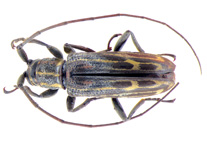Abstract
Orchesellinae specimens are distinguished from other Entomobryidae by a shorter fourth abdominal segment (length at the midline less than 1.8 times the third segment), generally more than four antennal segments, recurved labral setae and the presence of a complex metatrochanteral organ, with at least 11 spine-like setae, (Soto-Adames et al. 2008). Adult Dicranocentrus Schött specimens have the following characters: antennae with six segments, both fifth and sixth antennal segments annulated, 8+8 lenses in the eye patches, absence of a postantennal organ, apically rounded and/or truncated scales, pre-labral setae simple, not bifurcated, rows of spines on dens (present in most but not all species) and mucro bearing two teeth with a basal spine (Mari-Mutt 1976, 1981, Arlé & Mendonça 1982, Bellinger et al. 1996–2012). The genus is similar to other scaled Orchesellini genera such as Pseudodicranocentrus Mari-Mutt, 1981 and Dicranorchesella Mari-Mutt, 1977, but differs from these taxa by the presence of simple pre-labral setae (bifurcated in Pseudodicranocentrus) and by rounded and/or truncated scales (fusiform and apically pointed in Dicranorchesella) (Mari-Mutt 1977, 1980). Dicranocentrus is holotropical in distribution only four species recorded from Brazil: D. bicolor Handschin, 1924, D. silvestrii Absolon, 1903, D. termitophilus Handschin, 1924 and D. heloisae Arlé & Mendonça, 1982 (Abrantes et al. 2012). These species are restricted to northeastern and southeastern Regions (Abrantes et al. 2012). The new species is the first from Brazilian Amazon, north region of Brazil. The dorsal chaetotaxic scheme follows that of Mari-Mutt (1979).

